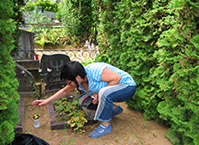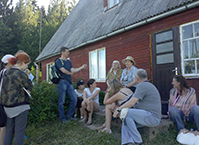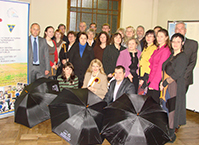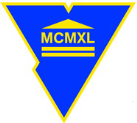Fashion
Categories: Residence and weekdays, Ira Motolyga
What was the fashion at the time?
What was the fashion? It wasn’t allowed to come to school without uniform. There appeared lisle and nylon stockings with a black heel, with a contoured heel, and we were girls, we didn’t finish school at the age of 17, we were probably age 18 and such postwar well-built girls. And in Borisov there was music on all the time at the dance terrace, and we wanted to dance so much, we had stockings in our pockets, and I had a friend, Valya Rusevich and now she is my girlfriend. Also Sveta Kopych, my girlfriend, and all the girls were well-built and nice. And we, therefore, go out of the school. Well, and thought where to go. We lived with grandmother. My grandmother used to cook a delicious jam. So, my grandmother gave us jam. She made tea, gave us some pancakes that she had cooked, and we ate jam. We liked to dress well. I used to dance very well! Later we did our hair.
What hairstyles did you have?
You know, I had always had very long hair, long and curly, I had curls hanging down. When I came in somewhere all the people shouted, «Wild Bara», such a film ran at that time. And the girls curled their hair, unplaited their braids, put bows, and made such roses of special ribbons. Such roses made of sewed ribbons were pinned to hair. We always did that. In summer we always wore socks, there were different socks, white socks, in blue and red stripes. We had socks for summer. When we went out at night. And also we wore so called rubber shoes, or white sneakers. We call them now cross trainers. Not ballet slippers, I have some like these now. Such slippers with laces, but white ones. And we rubbed them with tooth powder to make them white. We shook them off to avoid dusting down. We wore them with white socks. We wore staple dresses. Staple. At that time it was stylishly to wear a white staple dress in summer.
What model?
Model... it was a white staple dress, a long one. Well. There was such a band and a blue trimming here. And there was a kimono and a white trimming here. And there was a blue trimming here, too. If the girls didn’t have such a dress, they cried that they wanted such a dress. We all wore the same dresses. Also we had such blouses called «gutsulki». We embroidered them ourselves. They were embroidered, they were cross-stitched here. The dress material was batiste, thin batiste, very nice; you won’t find such material now. It was a natural batiste. A white one. We embroidered it here, and here. There were black pleated skirts. These were our clothes. But we wanted to wear deniers. But deniers were aggressively not allowed at school. The teachers kicked out of school, and in general, they called you to the pedagogical meeting to say that deniers are not allowed. So well. But we didn’t care and put them on. There weren’t any tights at that time. There weren’t any ever. There were waist-bands, yes, they were, but you have to do them up with special clasps. There were elastic ribbons on both sides. One needed to buy them, and then you kept it. If this elastic ribbon was torn you invent how to hook it, you never knew if you would buy it. Then there appeared such gumboots. They had heels and zipped on the side. They were made of gum, like boots. But you needed to insert a heel. And we, girls, had nothing to put in. So we put a potato into a heel and when walking the potato usually broke all the time. And we couldn’t walk anymore. It was nice that three of us were friends, we went together to dance. And there were some teachers who caught us on dancing in deniers. After that they called you to a blackboard at school, even if you answered well, she would put you a two-mark and would say, «I went there and saw you dancing there». So you see how we got dressed. And when we started to work, we wore what we liked.
What films were the most popular at that time?
Oh! I remember «Anna on the neck». I watched it very well, liked it very much. War films. First of all, we went to the cinema for the first time after the war, my sister led me up to the cinema. In Borisov it was a wooden building, and the film «Molodaya gvardziya» was running. I was watching and crying for the whole room that my sister wanted to take me away from the cinema. I remember this very well. And these artists, I remember them very well.
Did you often go to the cinema?
Yes, we did. We stood in a line to get tickets. The lines were very long; we stood to get the tickets. And also I remember we collected the pictures of the artists – the pictures of Druzhnikov, Kadochnikov. They were so handsome. And Kobzon, very young, sang songs, a wind band blared for the whole Borisov, Leschenko and Kobzon sang. We collected the pictures of these artists. And also, what was her name… I liked Larionova very much, and also an actress that acted a part of Shevtsova. And in general, my sister collected the faces of all «Molodaya gvardziya». What politics! I doubt that somebody knew who held a post in Kreml!
Images
Audio
Researcher: Наталья Иващенко, кандидат исторических наук, ГрГУ им. Я. Купалы, Светлана Силова, кандидат исторических наук, доцент, ГрГУ им. Я. Купалы











